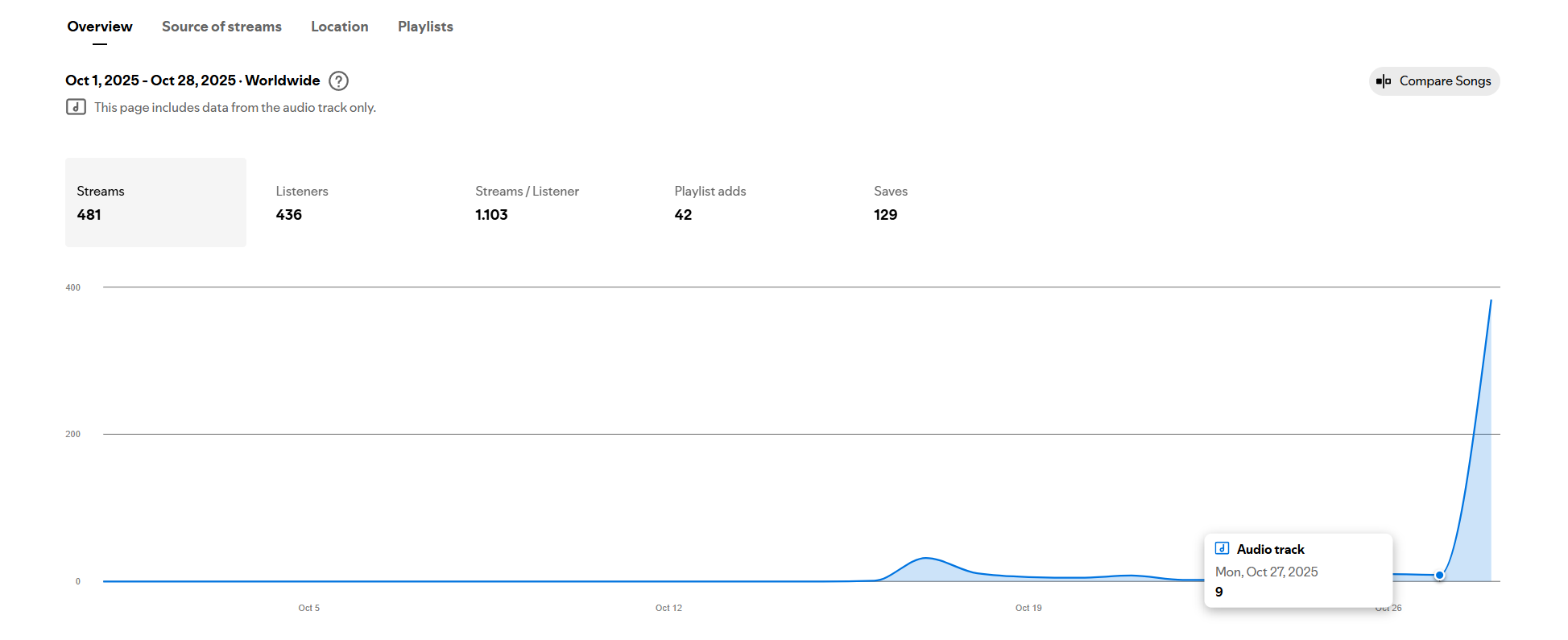The Platform Performance Gap: Why Instagram Outperforms Facebook for Spotify Conversions
A Report by Its21Master
For independent artists and labels running Meta Conversion Ads to drive streams and saves on Spotify, the question of placement selections - Facebook vs. Instagram - is crucial. Here at Its21Master, our internal data and extensive testing confirm a widely recognized industry trend: while Facebook often delivers significantly lower Cost Per Result (CPR) on paper, Instagram generates superior stream quality, follower growth, and algorithmic signals.
This report details our findings from recent A/B testing and provides a strategic framework for optimizing your placement strategy. We have included the comparison of 2 test campaigns - one where the ad campaign included Facebook placements, one where it only included Instagram placements.
The Conversion Discrepancy: Meta vs. Spotify
Our analysis reveals a stark contrast in performance metrics between the two primary Meta placements when optimizing for a 'Click to Streaming Service' conversion event. On Hypeddit, this would be “Hypeddit Smart Link Click”. For Feature FM, it’s “feature fm click”.
Facebook Placement Performance: High Volume, Low Quality
When running ads including the Facebook App placement (Feeds, Stories, Reels), the Meta Ads Manager reports high volumes of link clicks and conversions. To note, we started this campaign on 24 Oct 2025, so any stats before the 24th may be ignored.
High conversions from Facebook (e.g., 126 Link Clicks from Facebook App) Source: Hypeddit statistics
Little to no actual streams from the ads despite conversions reported on Facebook. (Ignore the uptick in streams at the most recent day, which is due to a playlisting campaign)
Facebook's conversion volume is deceptive. While the Meta Pixel registers the intended event (the click to Spotify), this traffic frequently results in a near-instant drop-off. The minimal stream counts and the slight increase in daily Saves (around 7) suggest that the majority of traffic is either low-intent, bot-driven, or from users who immediately bounce without meeting the 30-second stream threshold.
Instagram Placement Performance: Higher Quality, Better Algorithmic Signal
In contrast, we ran campaigns focused exclusively on Instagram Placements (Reels, Stories, Feed), which showed significantly superior results where it truly matters: on the Spotify for Artists platform. (literally the whole point of running a campaign lol)
An example of a test campaign we ran, with over 500 conversions and all from Instagram alone.
Spotify streams were significantly higher and actually reflected compared to Facebook-placed ads.
A much greater rate of uptick in saves as well, with an average save rate of 30% (Saves divided by Listeners). Instagram traffic shows a clear indication of high listener intent. The impressive increase in daily Saves (up to 56) is the "holy grail" metric, as a Save is a direct signal to the Spotify algorithm that a user intends to listen again.
The most telling difference between the two placements is evident in the Source of Streams data on Spotify for Artists. High-quality traffic from Instagram immediately generates the types of streams that activate the algorithm.
Definition of Artist Profile and Catalog: Streams generated when a user actively seeks out the artist or plays other music from their profile/discography. (The first streams from people who discover the song through ads would be registered as this) In this campaign, it increased: Higher numbers here confirm that new listeners are converting into active fans exploring your body of work.
Definition of Listener's Own Playlists and Library: Streams generated from a user's personal, saved content (Library, self-curated playlists). In this campaign, it significantly increased: This rise directly correlates with the high Save volume, proving the ad successfully converted a casual listener into a dedicated fan.
The Takeaway: Instagram is optimized for discovery and immediate consumption in a short-form, mobile-first environment, translating into listeners who are already primed to engage with new content and hit the Save/Follow button. Facebook, by contrast, is often treated as a browser where clicks are more incidental. We find that Instagram is where people are truly looking for new content to consume, while also having Spotify and being a qualified audience for conversions.
Strategic Recommendations for Placements
Based on our data, we recommend a nuanced strategy for music advertising:
Recommendation 1: Default to Instagram Placements
For the vast majority of genres (Pop, Hip-Hop, Indie, EDM, etc.), we strongly advise running conversion campaigns using Instagram Feed, Stories, and Reels as the primary, or often exclusive, placement. This ensures your budget is spent on high-intent, mobile-native audiences who are more likely to have Spotify Premium and less likely to be low-quality clickers.
Recommendation 2: Use Facebook for Niche Genres
Facebook still retains value for genres with an older, or more specific, active user base. Our testing showed that genres like:
Metal / Hard Rock
Country
Folk and Americana
...can see better engagement from the Facebook Feed placement. The audience for these genres tends to be slightly older and more accustomed to engaging with content within the traditional Facebook environment. When testing these niches, monitor your SFA data just as rigorously to confirm stream quality.
Recommendation 3: Mandate Tier 1 and Quality Tier 2 Targeting
The issue of low-quality clicks is magnified when combining poor placements with cheap geographies. To safeguard your campaigns, always target Tier 1 countries (US, UK, CA, AU, Germany, France) and vetted Tier 2 countries (like Brazil, or Mexico) to remove the possibility of bot traffic or click activity that doesn't translate into a 30-second stream.
By strategically separating your Meta placements and prioritizing Instagram for general music promotion, you ensure your advertising budget is consistently driving valuable, long-term growth signals to the Spotify algorithm.







